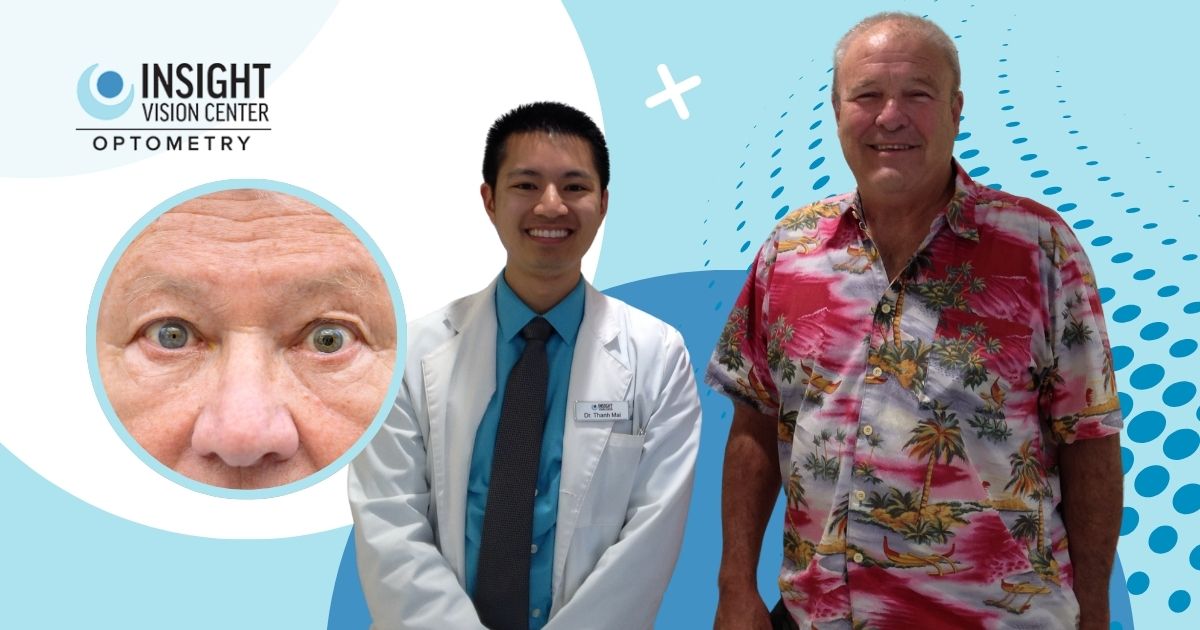
The Highest Rated Specialty Eye Care Center In Orange County

What Our Patients are Saying
“Dr. Mai and the entire personnel are amazing! Extremely polite, kind and professional. In addition, I can now see 20/20!!! Thank you, thank you all. 🤗🤗””
⭐⭐⭐⭐⭐
Franchezka
“Dr Mai and his team are awesome. They’re the best doing tests because, have the ultimate equipment with the last technology. And their customer service is unique “
⭐⭐⭐⭐⭐
Rene J.
Noticing that one pupil is larger than the other can be concerning. You may have questions like, “Is this normal?” or “Should I be worried?” This condition is fairly common and affects about 1 in 5 people. While most causes of unequal pupil size, known as anisocoria, are not a health concern, sometimes this can indicate serious underlying health issues that require immediate medical attention.
Are Different Sized Pupils An Emergency or Normal?
When Are Different Pupil Sizes Normal?
Physiologic anisocoria refers to a harmless and common type of unequal pupils that occurs in 10-20% of people. Pupil size difference is, typically around 0.4 mm and rarely exceeding 0.8 mm. The difference in pupil size remains consistent over time , does not fluctuate in different lighting conditions, and is not associated with symptoms, making it a normal occurrence that usually doesn’t require medical attention.
When is anisocoria an emergency requiring immediate medical attention?
While less common, different sized pupils can indicate a very serious health emergency that requires seeing a doctor without delay.
- Sudden changes to pupil size, especially if accompanied by headaches, vision changes, or confusion.
- Follows an injury such as a head injury.
- Pupil size changes in different lighting conditions
- Neurological symptoms such as dizziness, nausea, or weakness, which could suggest a more severe condition.
- Eye pain or discomfort that could indicate trauma or infection.
- Symptoms such as a droopy eyelid, inability to sweat, abnormal eye movements, eye sinking back into the socket, migraines, pain and the appearance of sunken eyes may indicate horner syndrome.
- Ptosis (drooping eyelid) alongside pupil differences, suggesting potential nerve involvement.
- Inflammatory symptoms such as redness and light sensitivity
Sudden changes to pupil size, especially if accompanied by headaches, vision changes, or confusion.
- Follows an injury such as a head injury.
- Pupil size changes in different lighting conditions
- Neurological symptoms such as dizziness, nausea, or weakness, which could suggest a more severe condition.
- Eye pain or discomfort that could indicate trauma or infection.
- Symptoms such as a droopy eyelid, inability to sweat, abnormal eye movements, eye sinking back into the socket, migraines, pain and the appearance of sunken eyes may indicate horner syndrome.
- Ptosis (drooping eyelid) alongside pupil differences, suggesting potential nerve involvement.
- Inflammatory symptoms such as redness and light sensitivity
If you notice any of these signs, don’t delay seeking medical attention. While these symptoms may not be a cause for concern, it is essential to diagnose the cause and rule out very serious conditions right away.
Serious underlying conditions associated with anisocoria
- Horner’s Syndrome: This condition often presents with a smaller pupil (miosis), drooping eyelid (ptosis), and potential loss of sweating on the affected side. Horner’s syndrome can result from various serious conditions, including tumors or carotid artery dissection. If accompanied by neck pain, it warrants immediate assessment. If you suspect Horner’s syndrome please call our office for specific guidance on your symptoms. Children with Horner’s syndrome should be closely monitored for potential concerns such as neuroblastoma.
- Adie’s Tonic Pupil: Typically features a larger, poorly reactive pupil that may respond to near stimuli. It primarily affects women aged 20 to 40.
- Third Nerve Palsy: Damage to the third cranial nerve can lead to a dilated pupil, drooping eyelid, outward eye deviation, and double vision. This condition can stem from serious causes like a brain aneurysm or trauma. Sudden onset of these symptoms requires urgent evaluation.
- Iritis and Uveitis: Inflammatory conditions that can cause pupil constriction in the affected eye, alongside symptoms such as redness, eye pain, altered vision, and light sensitivity.
- Pharmacological Effects: Certain medications may cause temporary anisocoria, necessitating an evaluation of recent drug use.
- Pathologic Causes: Anisocoria may also be a symptom of infections (like meningitis), trauma, or tumors affecting brain and optic nerve function. If you recently had an injury or infection you should schedule an emergency appointment
- Stroke or Intracranial Hemorrhage: These can present with anisocoria accompanied by neurological symptoms such as confusion, weakness, or significant headache.
- Eye Trauma: Any history of trauma, accompanied by pupil changes, warrants immediate examination as it could lead to complications.
If you observe sudden changes in your or your child’s pupil sizes, particularly with other symptoms, it’s crucial to schedule an emergency eye exam immediately, early intervention is the best way to prevent possible complications.

Should you see an eye doctor for different sized pupils?
If you are unsure if your symptoms require an emergency eye exam please call us for guidance at (714) 942-1361. At Insight Vision Center Optometry, our expert eye doctors—Dr. Nathan Schramm, Dr. Ariel Chen, Dr. Valerie Lam, and Dr. Nhi Nguyen—provides urgent medical and emergency eye care for children and adults. With specialized training and access to the latest technology, our eye doctors are here to provide patients from across Orange County with the highest level of care.
Complications and Potential Health Risks
While the vast majority of cases of anisocoria do not cause permanent damage, early diagnosis and treatment is critical to prevent serious complications such as:
- Stroke or Aneurysm: Anisocoria can be a red flags for strokes or aneurysms, particularly in the context of third nerve palsy or Horner’s syndrome. Immediate evaluation can be crucial in these scenarios.
- Brain Tumors: Changes in pupil size, especially if progressive, may warrant imaging tests to rule out space-occupying lesions in the brain.
- Neurological Complications: Persistent anisocoria may signal underlying neurological disorders. This condition can complicate diagnoses and may require a referral to a neurologist or neuro-ophthalmologist.
- Vision Impairment: While anisocoria itself may not cause vision loss, underlying causes such as trauma, infection, or inflammation can pose significant risks to your eyesight if not treated promptly.
A Deeper Look at Mechanical Anisocoria
Mechanical anisocoria occurs due to direct trauma or structural changes in the eye. It is often linked to:
- Eye Injuries or Surgery: Physical damage to the iris or surrounding structures.
- Inflammatory Conditions: Issues like uveitis or angle-closure glaucoma.
- Congenital Abnormalities: Structural defects affecting the pupil.
Common symptoms include blurry vision, light sensitivity, and eye pain or discomfort.
If anisocoria develops after an eye injury or surgery, or if these symptoms are present, seek medical attention immediately to prevent further complications.
Can Medications Cause Different Pupil Sizes? Pharmacologic Anisocoria Explained
Certain medications and medical conditions can cause anisocoria by dilating (mydriasis) or constricting (miosis) the pupils. Key contributors include:
Non-emergency complications from Anisocoria
Typically uneven pupils does not cause health issues, however the underlying cause of this symptom may result in minor complications such as:
Unique Considerations for Pediatric Patients
As a parent or caregiver, noticing that one pupil is larger than the other in your child can be alarming. Anisocoria, the medical term for pupils of different sizes, is normally benign, but it raises critical considerations in pediatric patients. Children may not always be able to articulate any discomfort, so it’s essential to observe any accompanying symptoms, such as drooping eyelids (ptosis), difficulty seeing, or unusual reactions to light.
Children are particularly vulnerable to conditions that may lead to anisocoria, including Horner’s syndrome. This syndrome can arise due to developmental issues or birth trauma and may sometimes indicate more serious concerns like neuroblastoma, a nervous system cancer that predominantly affects young children.
Diagnosis & Treatment of Anisocoria
The treatment of anisocoria varies based on the underlying cause or condition. Most causes of anisocoria only require observation by an eye doctor. In certain cases your eye doctor may refer patients to a neuro-ophthalmologist, ophthalmologist, retina specialist, or neurologist. Our Costa Mesa clinic offers advanced emergency eye care to patients from nearby cities such as Irvine, Santa Ana, and Huntington Beach.
Initial Patient History and Symptom Assessment
When evaluating anisocoria, a detailed patient history is essential. Our practitioners will ask about:
- The onset and duration of the condition—whether the anisocoria is new or something that has been noticed for a long time.
- Any accompanying symptoms, such as headaches, light sensitivity, or changes in vision.
- Previous medical history, including any recent head injuries or eye surgeries, which could provide context for the condition.
- Current medications, as some drugs can affect pupil size, leading to pharmacologic anisocoria.
Physical Examinations and Tests
After history-taking, a thorough physical examination follows. The eye doctor will:
- Assess both pupils under varying light conditions—first in ambient light and then in darkness—to evaluate their response to stimuli.
- Perform a pupillary reflex test by shining a light in each pupil to observe their direct and consensual reactions.
- Use a slit-lamp microscope for an in-depth examination of the eye structures, which can reveal any associated ocular conditions that might explain the anisocoria.
- Conduct a neurological assessment to check for associated signs of cranial nerve involvement or other neurological issues.
- Additional tests may be performed such as OCT, fundus fluorescein angiography or indocyanine green angiography, fundus autofluorescence, ultrasonography, CT and MRI based on symptoms
Using Pharmacological Agents for Diagnosis
In some cases, specialized pharmacological tests may be used to help determine the cause of anisocoria:
- A medication like apraclonidine may be instilled to assess the reaction of the affected pupil, potentially confirming conditions such as Horner’s syndrome.
- Low doses of pilocarpine can help distinguish between an Adie’s tonic pupil and a third cranial nerve palsy by observing how the pupils respond.
- Hydroxyamphetamine may also be used for further investigation if Horner’s syndrome is suspected, based on its ability to indicate the specific location of nerve impairment.
It is important to understand that the use of these pharmacological agents is a crucial part of the diagnostic process and can help avoid potential misdiagnoses.
Treating Anisocoria by Addressing Underlying Causes
Effective treatment of anisocoria focuses on identifying and managing the underlying condition. Common causes and their treatments include:
- Iritis and Uveitis: Inflammatory conditions managed with corticosteroid or anti-inflammatory eye drops.
- Horner’s Syndrome: Requires diagnosis of the cause, such as tumors or nerve compression, with tailored treatments that may include surgery.
- Adie’s Tonic Pupil: Often benign, but pilocarpine drops can help alleviate visual symptoms.
- Third Nerve Palsy: Immediate imaging is essential to rule out serious conditions like aneurysms, with treatment focused on the underlying cause.
- Mechanical Anisocoria: Caused by trauma or structural changes. Treatment may involve:
- Immediate Care: Pain relief, anti-inflammatory medications, or surgery for structural damage.
- Surgical Intervention: To correct traumatic or mechanical changes in iris function.
- Observation: Monitoring is recommended for cases without symptoms or serious complications.
- For pharmacological anisocoria, adjusting or switching medications (e.g., glaucoma drops, SSRIs) can help resolve the issue. Pilocarpine may also be used for specific conditions like Adie’s pupil.

Orange County’s Leading Emergency Eye Care Clinic
At Insight Vision Center Optometry, we provide world-class emergency eye care to patients across Orange County. Conveniently located in Costa Mesa, our clinic is recognized for delivering prompt and effective care for urgent eye issues. Whether you’re from Irvine, Huntington Beach, or Santa Ana, our team of highly qualified eye doctors is ready to help with any eye emergencies. From trauma to infections, we offer comprehensive solutions tailored to each patient’s needs.
Call us at (714) 942-1361 to book your child’s appointment, or schedule online.





